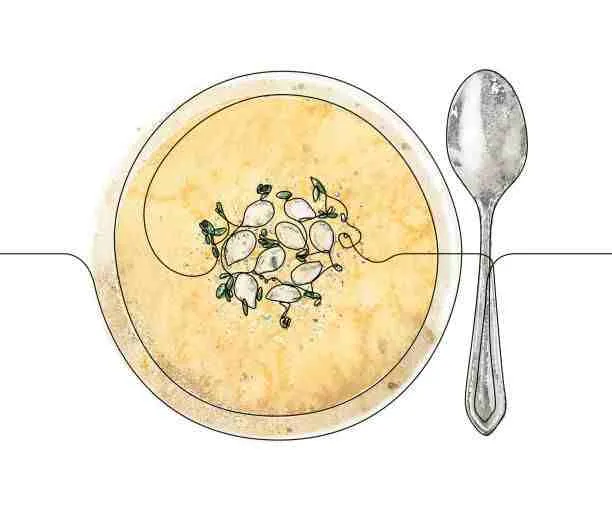'How the World Eats' unpacks global food system complexities
Julian Baggini examines the ethics, production, and cultural impact of food.
 |
| Illustration by Andrea Hill |
By Hayu Andini and Adila Ghina
The global food system is a vast and often chaotic network of businesses, institutions, and industries dedicated to feeding people. It ranges from small organic farms to massive agribusiness corporations, some of which operate in isolation while others are deeply interconnected. Philosopher Julian Baggini challenges the very notion of a structured "food system" in his latest book, How the World Eats, arguing that such a term is too broad to define clearly. Instead, he introduces the concept of the “food world,” encompassing everything that influences and is influenced by human food consumption.
Through extensive research and global travel, Baggini investigates the ethical, economic, and cultural complexities of food production and distribution. From child labor in cocoa plantations to high-tech fish farms, his book offers an in-depth look at how food is grown, transported, and consumed across different regions.
A philosophical approach to food and ethics
Baggini is no stranger to exploring food through a philosophical lens. In 2014, he published The Virtues of the Table: How to Eat and Think, a collection of essays that encouraged mindfulness in everyday food choices. However, How the World Eats shifts the focus from personal consumption to the broader implications of industrial food production.
The book delves into ethical dilemmas surrounding the global food trade, examining the balance between traditional farming practices and modern agricultural advancements. Baggini discusses the challenges of feeding a growing population while addressing concerns about sustainability, labor rights, and cultural identity.
A global journey through food production
Baggini’s research takes him across continents, exploring the realities of food production in diverse environments. He visits cocoa plantations in Ghana, where many farmers earn less than the price of a single chocolate bar per day. He examines state-of-the-art fish farms in Panama, where offshore netting systems allow for large-scale fish production while mitigating some of the environmental concerns of inland farms.
Throughout the book, Baggini also provides historical context, linking modern food practices to ancient traditions. He explores the diets of hunter-gatherer societies, such as Tanzania’s Hadza people, whose diverse gut microbiomes reflect a diet rich in natural, unprocessed foods. He also traces the evolution of industrial food preservation, from NASA’s early space missions—where astronauts struggled with monotonous meal options—to modern food processing techniques designed for mass consumption.
The complexities of food ethics and sustainability
One of the book’s most compelling themes is the nuanced debate between organic farming and industrial agriculture. Baggini challenges the common belief that organic methods are always superior, pointing out that they are not universally effective for all crops and regions. He also highlights the potential benefits of high-tech farming practices, such as no-till agriculture, which improves soil health through minimal disruption and strategic pesticide use.
Similarly, he examines the role of nitrogen fertilizers, which are often criticized for their environmental impact. Baggini argues that synthetic fertilizers could become sustainable if produced using renewable energy, challenging the prevailing notion that all artificial agricultural inputs are inherently harmful.
This balanced perspective extends to his discussion of genetically modified organisms (GMOs), lab-grown meat, and large-scale farming operations. Rather than taking a firm stance for or against these innovations, he presents them as tools that must be evaluated within their specific contexts.
The power dynamics shaping global food systems
One of the book’s underlying themes is the role of power in shaping the food industry. Baggini acknowledges the influence of multinational corporations, government policies, and market forces in determining how food is produced and distributed. However, he stops short of offering concrete solutions, instead emphasizing the complexity of the issue.
For instance, after detailing the exploitation of laborers in the cocoa and coffee industries, he concludes that achieving a fairer food system requires market reforms rather than a complete overhaul. While this pragmatic approach acknowledges the realities of global economics, it may leave some readers wanting more decisive action.
The balance between information and reflection
Baggini’s strength lies in his ability to present detailed, well-researched information. His writing is rich with historical anecdotes and scientific insights, making How the World Eats an engaging read for those interested in food history, economics, and sustainability. However, his commitment to nuance sometimes results in conclusions that feel cautious or indecisive.
For example, while he effectively outlines the challenges of industrial food production, he does not propose a unified theory for addressing them. Instead, he encourages readers to embrace complexity and approach food choices with an open mind.
A thought-provoking look at the world of food
Despite its broad scope, How the World Eats succeeds in offering a thought-provoking exploration of the global food industry. Baggini’s detailed research and historical context provide valuable insights into the intricate web of food production, distribution, and consumption.
While the book does not provide simple solutions, it encourages readers to think critically about the food they eat and the systems that sustain it. For those with an appetite for knowledge, How the World Eats serves as an informative and engaging guide to the ever-evolving food world.
More from Book Review
- Andrew Lipstein’s latest novel reimagines Hamlet’s themes in a modern setting.
- Virginia Feito’s new novel blends psychological horror and gothic revenge.
- Hiromi Kawakami’s novel blends hard science fiction with deep reflections on motherhood, survival, and the end of humanity.
